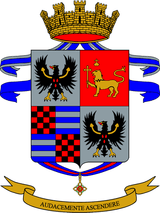11th Alpini Regiment
The 11th Alpini Regiment (Italian: 11° Reggimento Alpini) is an inactive regiment of the Italian Army's mountain infantry speciality, the Alpini, which distinguished itself in combat during World War I and World War II.
| 11th Alpini Regiment | |
|---|---|
| 11° Reggimento Alpini | |
 Coat of Arms of the 11th Alpini Regiment | |
| Active | 22 December 1935 – 12 September 1943 8 August 1992 – 18 March 2002[1] |
| Country | Italy |
| Branch | Italian Army |
| Type | Alpini |
| Role | Mountain Infantry |
| Size | 3 Battalions Bolzano Battalion Trento Battalion Bassano Battalion |
| Part of | 5th Alpine Division Pusteria 1935 - 1943 |
| Garrison/HQ | Bruneck |
| Motto(s) | "Audacemente ascendere"[1] |
| Anniversaries | 15 February 1936 - Battle of Amba Aradam[1] |
| Engagements | Second Italo-Abyssinian War World War II: Battle of France Greco-Italian War |
| Decorations | 1x Military Order of Italy 2x Silver Medals of Military Valour 2x Bronze Medals of Military Valour 1x Bronze Medal of Red Cross Merit [1] |
| Insignia | |
| Alpini gorget patches | |
History
Formation
On 22 December 1935 the 11th Alpini Regiment was formed in the city of Bruneck with existing battalions from other Alpini regiments:




On 1 January 1936 the regiment was subordinated to the newly created 5th Alpine Division "Pusteria" and sent with the division to Eritrea to fight in the Second Italo-Abyssinian War
Ethiopia
For the war the Pusteria had been augmented by the "Exilles" and "Intra" battalions and four artillery batteries form the 1st Alpine Division "Taurinense". The Pusteria participated in all battles of the Northern Theater and the 11th regiment distinguished itself during the Battle of Amba Aradam, for which it received its first Bronze Medal of Military Valour. The division returned to the Italy in 1937 and was honored with a parade through the streets of Rome on 13 March 1937.
World War II
After its return the regiment was reorganized, returning two battalions to their original regiments. As replacement the regiment received an existing battalion and raised another one. Thus as of 11 April 1937 the new structure of the regiment was:




On 21 June 1940 (one day before the French surrender) the Pusteria division began to advance into southern France during the last days of the Battle of France.
Afterwards the 11th Alpini was sent to Albania, where it participated in the Italian attack on Greece. After the German invasion of Yugoslavia the Pusteria and its units were sent to Montenegro, where the division was decimated in heavy fighting against Yugoslavian Partisans.
In August 1942 the division was repatriated, and after two months of rest participated in Case Anton - the Axis occupation of Vichy France. Afterwards the Pusteria took up garrison duties in the southern region of Provence. After the signing of the Italian armistice with the Allies on 8 September 1943 part of the division surrendered to German forces in Southern France while other units managed to return to the Italian region of Piedmont were they disbanded.
1990s
With the reintroduction of the regimental level in the Italian Army in 1991/1992 the regiment was reformed on 8 August 1992 in Bruneck as part of the Alpine Brigade "Tridentina". The regiment only consisted of the "Trento" battalion. Battalion and regiment were dissolved on 18 March 2002.
Structure
When the regiment was disbanded it had the following structure:
References
- "Le Feste dei Reparti - Febbraio". Italian Army. Retrieved 17 November 2019.
- F. dell'Uomo, R. Puletti (1998). L'Esercito Italiano verso il 2000 - Vol. Primo - Tomo I. Rome: SME - Ufficio Storico. p. 479.
Sources
- Franco dell'Uomo, Rodolfo Puletti: L'Esercito Italiano verso il 2000 - Volume Primo - Tomo I, Rome 1998, Stato Maggiore dell'Esercito - Ufficio Storico, page: 498